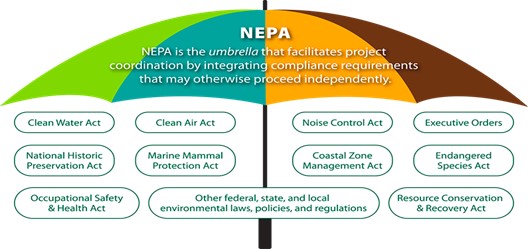NEPA (National Environmental Policy Act) Process Reforms
By Mark Kohout – Senior Regulatory Specialist & Midwest Regional Manager Rolling Meadows (Chicago)
Mark is a seasoned Senior Regulatory Specialist and Midwest Regional Manager with over three years of experience in regulatory compliance. With a commitment to upholding industry standards and fostering regulatory excellence, Mark continues to make a significant impact in the Midwest region.

Introduction
The National Environmental Policy Act (NEPA) has long required federal agencies to evaluate the environmental impacts of major projects—ranging from highways and pipelines to renewable energy developments. Recent reforms are designed to streamline this process by shortening review timelines, expanding categorical exclusions, and limiting the scope of impact analyses.
These changes could significantly affect developers, contractors, and federal agencies seeking faster approvals, as well as communities, tribes, and environmental groups concerned about reduced opportunities for input and oversight. In practice, the reforms shift the balance between speed and scrutiny, raising both opportunities and compliance risks across industries that rely on federal permitting.
- What Changed in NEPA
-
Recent reforms (highlighted by firms like Holland & Knight) focus on:
- Shortening Environmental Assessments (EA) and Environmental Impact Statements (EIS) timelines.
- Stricter page limits and deadlines for agencies.
- More categorical exclusions (CEs) for common project types.
- Expanded use of programmatic reviews to cover multiple projects under one analysis.
- Limits on cumulative impacts review (e.g., greenhouse gas emissions, climate change).
- Why It Matters
- Infrastructure & Energy Projects: Quicker approvals could benefit highways, pipelines, renewable projects, and federal land development.
- Industry View: Developers and contractors argue reforms cut “red tape” and allow projects to move forward with predictability.
- Community/Environmental View: Tribes, environmental groups, and EJ advocates warn these shortcuts could sideline meaningful input, underplay cumulative harms, and increase litigation risk.
- Legal and Compliance Challenges
- Anticipated lawsuits testing whether streamlined reviews violate NEPA’s statutory intent.
- Agencies face pressure: comply with strict deadlines and ensure defensible documentation to withstand judicial review.
- Risk of more projects being halted in court because shortened reviews fail to meet evidentiary standards.
- Balance of Priorities
- Economic growth vs. environmental protection: Will these reforms really accelerate infrastructure investment, or will they generate more litigation delays?
- Tribal consultation: A hot-button issue—are voices being marginalized when timelines are compressed?
- Climate implications: Limiting cumulative impacts analysis could downplay climate risks in environmental decision-making.
- Future Outlook
- Watch for agency rulemakings clarifying new NEPA procedures.
- States may fill gaps with stricter local review processes (e.g., California CEQA).
- The 2026 election cycle could swing reforms again—businesses and communities face uncertainty in long-term planning.